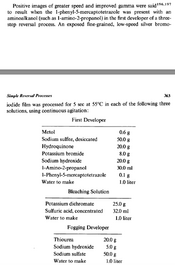Hi all,
I know that thiourea/toners have been used as a fogging developer in the black and white reversal process. But, when reading about reversal processing in Haist he presents a process that consist of first developer, bleach, and the thiourea fogging developer. No clearing, no re-exposure and no fixing. I've been using dithionite which is convenient as re-exposure and second development is the same step, but its still necessary to clear after bleaching and fix in the end.
So I guess my question is, did anyone use thiourea or some sort of toner as a fogging developer in the reversal process? If so, how as it done and whats the steps of the process?
Cheers
Peter
I know that thiourea/toners have been used as a fogging developer in the black and white reversal process. But, when reading about reversal processing in Haist he presents a process that consist of first developer, bleach, and the thiourea fogging developer. No clearing, no re-exposure and no fixing. I've been using dithionite which is convenient as re-exposure and second development is the same step, but its still necessary to clear after bleaching and fix in the end.
So I guess my question is, did anyone use thiourea or some sort of toner as a fogging developer in the reversal process? If so, how as it done and whats the steps of the process?
Cheers
Peter













